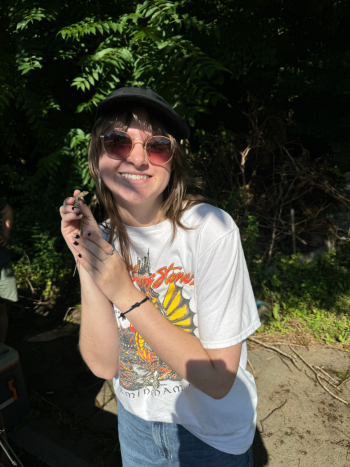
Through the Summer Undergraduate Research Experience (SURE) program this summer, supported by the Environmental Science and Design Research Institute (ESDRI), senior Zoology major & Music minor Allison Remick continued a research project she has been developing for nearly two years. Mentored by Brian Trevelline, PhD (Department of Biological Sciences), Remick’s work investigates the relationships between microbes and their hosts, focusing on the common wall lizard (Podarcis muralis), an invasive species, in Cincinnati. Remick said that this project is part of a larger project in the Trevelline lab, stating, "The main goal of the lizard project was to rear germ-free hatchlings to see how the microbiome affects their growth and metabolism in early life."
“My project aims to determine if there are microbes present within the egg during its development through the internal oviduct of the mother,” Remick explained. “It also aims to determine if the number of bacterial colonies present correlates with the concentration of an enzyme called lysozyme, which is found in large quantities in eggs. This enzyme kills cells by destroying their cell wall; but if there are living bacteria within the egg, then there must be microbes that lysozyme has no effect on. Results of this project could suggest the inheritance of the maternal microbiome by hatchling wall lizards, which would give them a necessary boost to their microbiome in their earliest stages of life.”
The work has been demanding and required persistence. “This project has been nearly two years in the making, and I’ve had to do a lot of repetitive work in that time,” Remick said. “I’ve been attempting to determine the bacterial load of my egg samples by performing 16s rRNA qPCR. However, I have been struggling with contamination since I began testing my samples in November of ‘24. Despite running these assays multiple times a week for almost a year, I am still pushing through and being as patient with myself as possible! I know the data I get will be worth the effort.”

The project has also shaped Remick’s future plans. “As an undergraduate in my senior year, I have started looking at graduate programs to pursue my PhD in Ecology and Evolutionary Biology. I’ve had to put a lot of thought into each place I look at, as well as take into account the needs of the people in my life. It was definitely a challenge to decide which places I wanted to apply to. I also had to think about what I want to research in grad school and make sure I’m not too ambitious!”
For Remick, support from the institute made a big difference. “Being supported by ESDRI was very helpful! Being able to speak with Katherine [ESDRI postdoc] about my project was enjoyable, as it’s always nice to share my research with new people. It also made me feel as though I was a part of something larger than myself or my lab. I was inspired to join ESDRI as a fellow this year because of their support throughout the SURE program!”
With patience, persistence, and support, Remick is pushing forward in uncovering the hidden microbial world inside lizard eggs - research that could shed light on how mothers pass essential microbes to the next generation.

